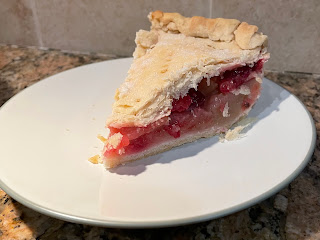Because I also like cranberries, about 10 or so years ago, I decided to give a cranapple pie a try. Since then it's replaced the traditional apple pie as part of our Thanksgiving Day dessert options. If you are making an apple pie and have some whole cranberries on hand (dried cranberries would likely work as well), that's all you need.
Here is how I put my cranapple pie together. The recipe is for a 9-inch pie, but you can scale up or down depending on the size of pie you would like to make. With fewer of us at home for Thanksgiving this year, I will scale down for a 7-inch pie. We still want all three of our pie options, but three full-size pies are a bit too much for us, even if we justify cranapple pie for breakfast as "fruit pastry."
Filling for a 9-inch cranapple pie:
- 3/4 cup white sugar
- 1/4 cup flour
- 1/2 teaspoon ground nutmeg
- 1/2 teaspoon cinnamon
- dash of salt
- 6 cups thinly sliced and pared apples (I like Granny Smith, but use what you prefer)
- 1/2 cup or so of fresh cranberries - stir them in and see if the combination looks right to you.
- 1/4 cup of walnuts (optional - I've used them some years, but not others - your choice)
- 2 tablespoons of margarine or butter
- 2/3 cup plus 2 tablespoons of shortening (I use Crisco sticks and keep them in the freezer until I'm ready to use them)
- 2 cups flour
- 1 teaspoon salt
- 4-5 tablespoons of cold water
- Stir the dry ingredients together.
- Stir in the apples, cranberries, and walnuts (if using). You will end up with a mixture that looks something like this. Don't worry if it looks as though the cranberries aren't totally evenly distributed. It all works out during the baking.
- Stir the flour and salt together
- Cut the shortening into the flour and salt using a pastry cutter until the shortening particles are the size of small peas and the mixture is crumb like. Alternatively, you could put the mixture into a food processor and pulse it a few times. If you do, be careful not to run the processor too long, or the shortening will start to melt which will alter the texture of the pie crust.
- Sprinkle the water in about a tablespoon at a time and mix it in with a fork. This helps you avoid overworking the crust and making it too tough. If needed add in a tablespoon or more of water to get it all to come together.
- Divide the crust in half. Roll out the bottom layer, and line the pie pan with it.
- Spoon the pie filling into the crust-lined pie pan.
- Dot the top of the filling with the cut up pieces of margarine or butter.
- Roll out the top crust layer, seal and flute the edges. I'm not really an artist when it comes to pie crust edges. I just kind of crimp and roll them together.
- Cut slits in the top and sprinkle with a little sugar or cinnamon sugar if desired.
- Cover the edges with a strip of aluminum foil to keep them from burning. Remove the foil after the pie has baked for about 20 minutes or so.
- Bake in a 425ºF oven for about 40 minutes or so until the crust is slightly browned and you can see the juices bubbling through the slits in the top crust.

